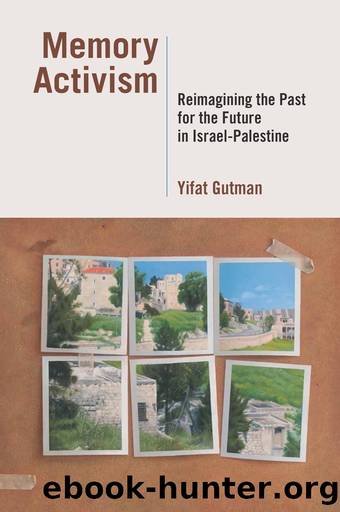Memory Activism by Yifat Gutman

Author:Yifat Gutman [Gutman, Yifat]
Language: eng
Format: epub
Tags: Social Science, Violence in Society, Political Science, World, Middle Eastern, Human Rights
ISBN: 9780826503916
Google: U7wpEAAAQBAJ
Publisher: Vanderbilt University Press
Published: 2021-04-30T05:49:14+00:00
5
From Reconciliation without Truth to Truth without Reconciliation
The Israeli collective memory is Zionist. . . . The heavy price Arab Palestinians paidâin life, the destruction of hundreds of villages, and refugeeismâis almost without public recognition. The manipulation of constituting the collective memory also prevents the Jews from acknowledging their part of the destruction, carry the responsibility for it, and reach actual reconciliation with the Palestinians. . . . Physically marking the [Palestinian] villages and public debateâJewish and Palestinian, apart and togetherâwould encourage the constitution of a more moral discourse, . . . and express a true will to reconcile. (Eitan Bronstein, Hakibutz newspaper, 2001)
The acknowledgement I am declaring today belongs to a glorious tradition I am proud to join. Public admission of guilt is not a weaknessâquite the opposite: it expresses the human desire for reconciliation. Leaders who have ignored the suffering they have caused to other nations and human groups have come to recognize that it is impossible to seek reconciliation and true peace without acknowledging the crimes their nations have perpetrated. (Rafi Shtendel, chairperson, New KKL-JNF website, 2013)
The first text was published in the months that preceded the formation of Zochrot as an organization that would remind Jewish Israelis and mark the Palestinian life that was lost in the 1948 war. Eitan Bronstein portrayed the idea behind the organization in a 2001 article of the magazine of the kibbutzim movement. In these early days, the idea was that airing the Palestinian past in public (through signage that marks the destructed villages), an act of recognition in itself, may lead Jewish Israelis to publically acknowledge the Palestinian displacement and destruction in 1948. Such recognition and acknowledgment could enable Jewish Israelis to take responsibility for their part in the Palestinian loss and by so doing, pave the way to reconciliation. Another outcome would be opening public debate to a âmore moral discourse,â thus creating a better society. Bronstein proposed that every kibbutz would post a sign marking the Palestinian villages that existed on its lands or near them before 1948.
The article received mostly negative responses from kibbutzim members, who claimed, for example, that such signs should also note the violence Palestinian residents of some of these villages inflicted on their pre-1948 Jewish neighbors, or that the signs are not a good idea as they may lead Palestinian refugees to claim their properties or a return to their lands.1 Wakim Wakim, then the general secretary of the Association for the Defense of the Rights of the Internally Displaced (ADRID), the main organization of Palestinian refugees in Israel, was asked by the newspaper to respond to Bronsteinâs article. He noted that a similar idea had been raised by ADRID, yet he expressed ambivalence about it. He believed that such signposting should be agreed on by both sides, Jewish and Palestinian citizens, and receive the necessary state approval, yet he expressed concern that the state would take advantage of the signs to shape history in a manner that once again reflects its interests.
Download
This site does not store any files on its server. We only index and link to content provided by other sites. Please contact the content providers to delete copyright contents if any and email us, we'll remove relevant links or contents immediately.
| Civil Rights | Discrimination |
| General | Human Rights |
Day by Elie Wiesel(2720)
The Age of Genius by A. C. Grayling(2544)
Gideon's Spies: The Secret History of the Mossad by Gordon Thomas(2304)
The Gulag Archipelago (Vintage Classics) by Aleksandr Solzhenitsyn(2048)
FATWA: Hunted in America by Pamela Geller(1972)
Columbine by Dave Cullen(1819)
Men Explain Things to Me by Rebecca Solnit(1693)
The Rule of Law by Bingham Tom(1651)
Anatomy of Injustice by Raymond Bonner(1619)
Examples & Explanations: Administrative Law by William F. Funk & Richard H. Seamon(1602)
Three Cups of Tea by Greg Mortenson(1577)
That Every Man Be Armed by Stephen P. Halbrook(1548)
The Source by James A. Michener(1539)
ADHD on Trial by Michael Gordon(1532)
Gideon's Spies by Gordon Thomas(1472)
Future Design by Unknown(1469)
Palestinian Walks by Raja Shehadeh(1459)
Constitutional Theory by Carl Schmitt(1413)
Nothing to Envy by Barbara Demick(1387)
